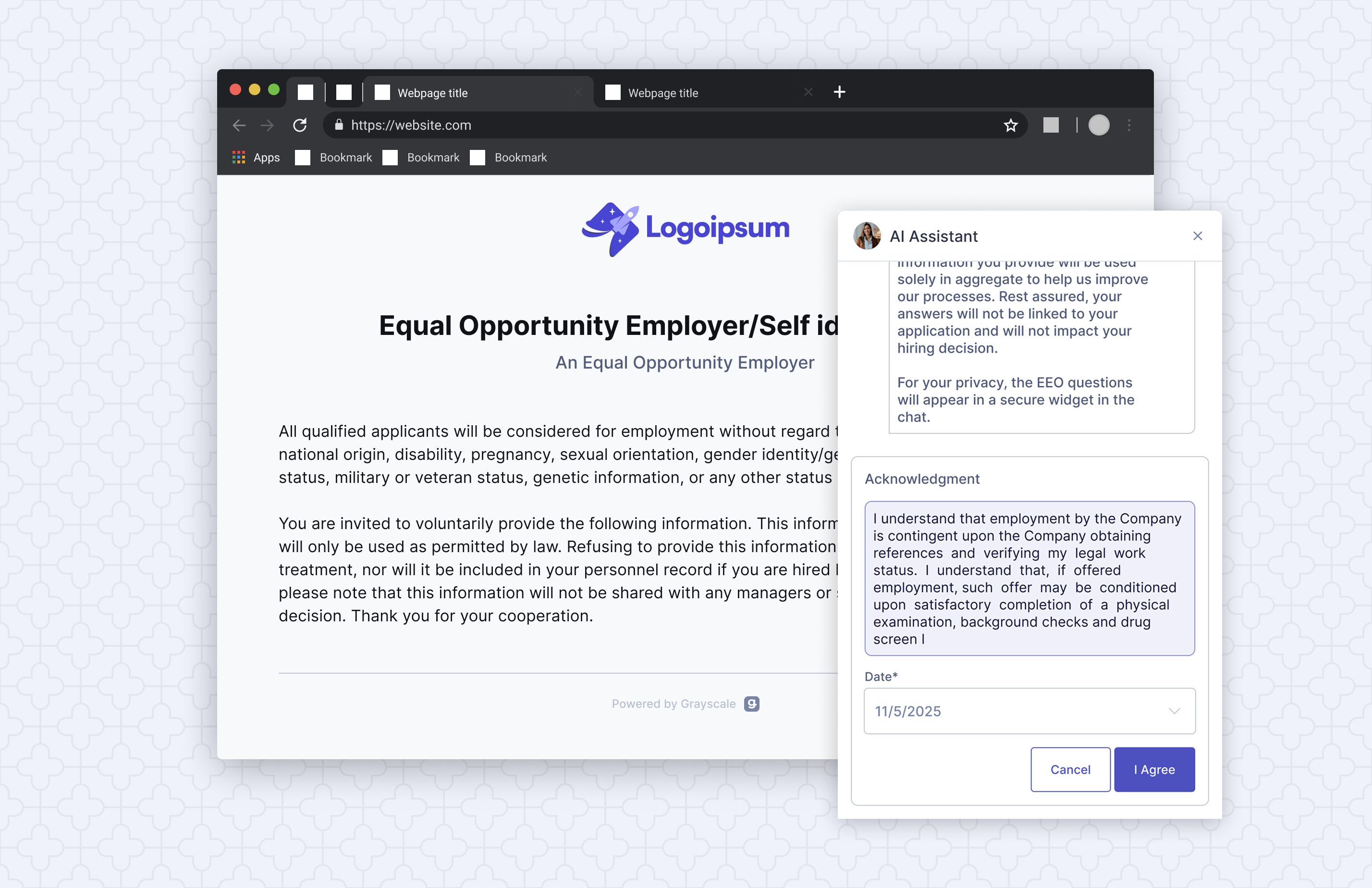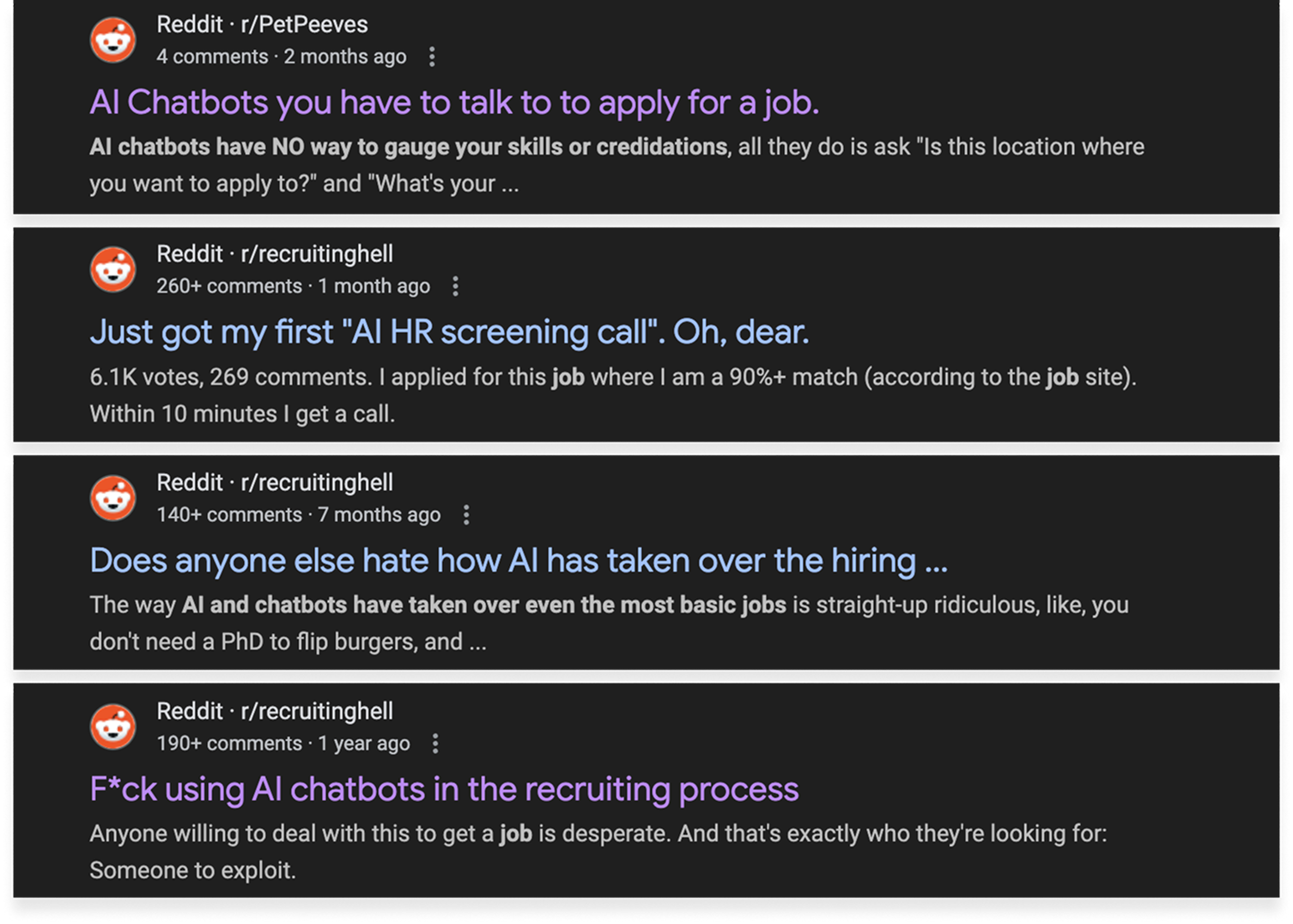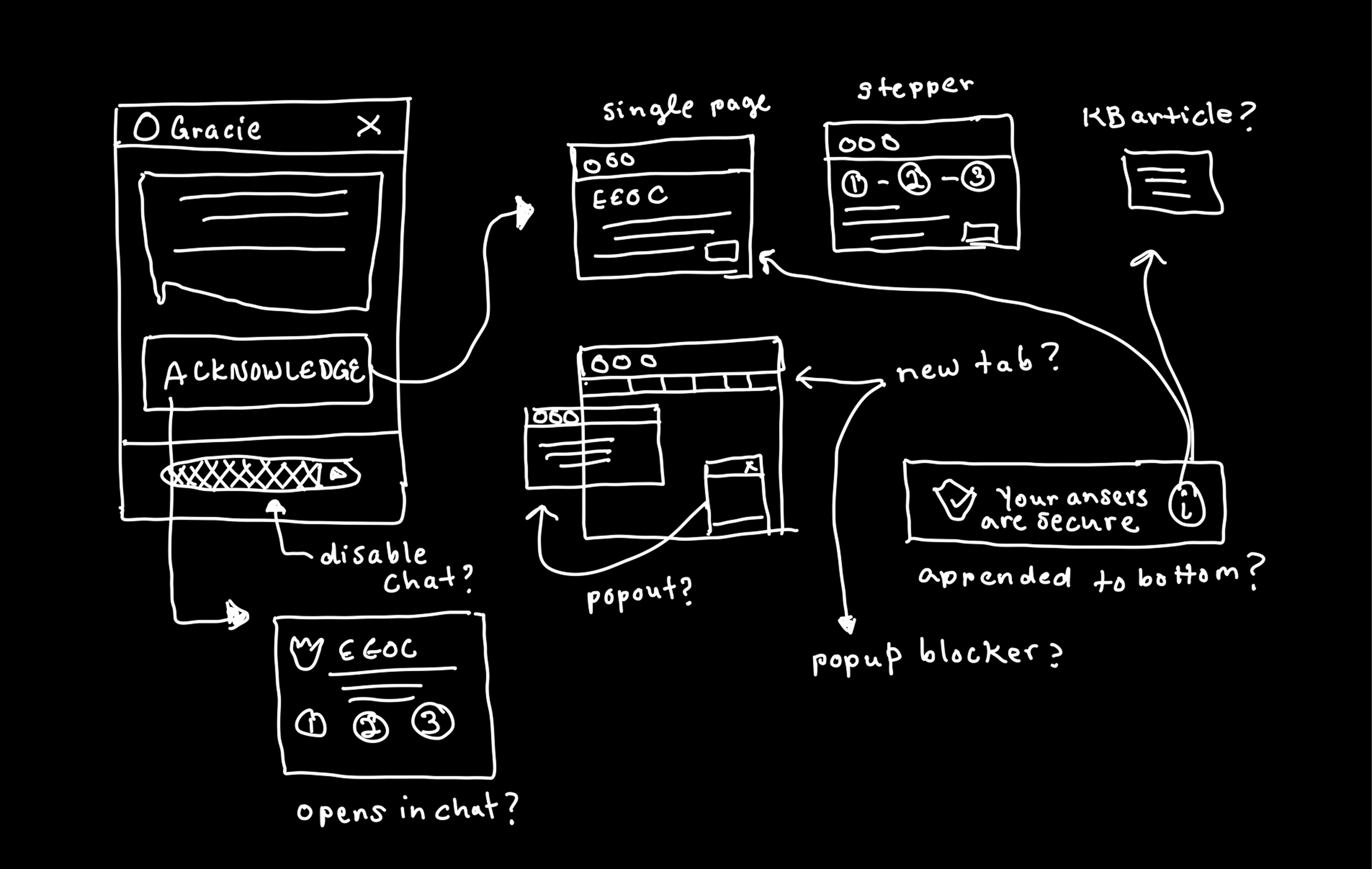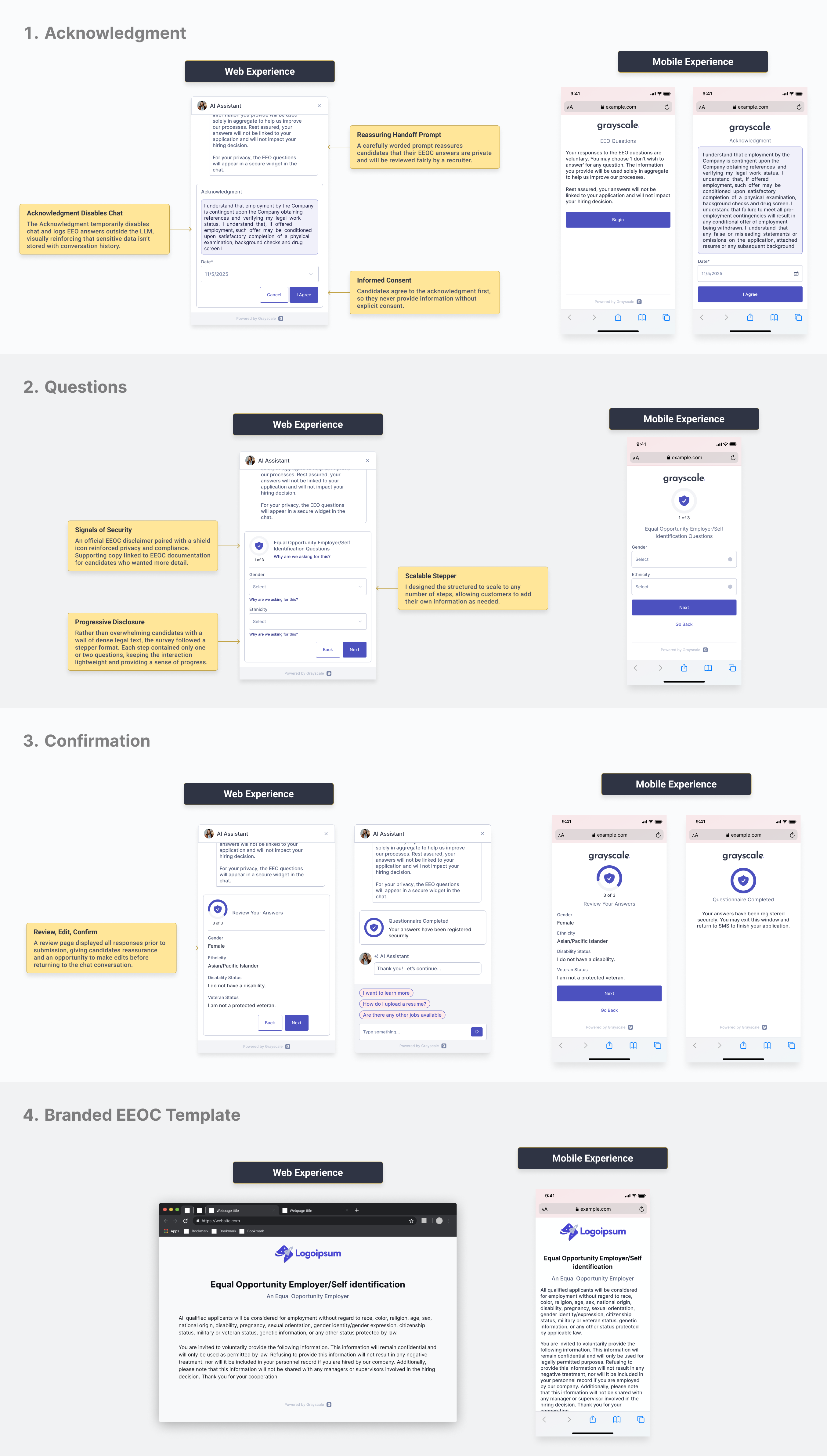🚫📄
No Document Uploads
Candidates couldn’t upload documents like resumes directly to Gracie. Redirecting them to external links interrupted the conversation & increased the risk of dropoff.

Grayscale is a B2B2C hiring platform that integrates with customers’ ATS to automate high-volume recruiting. At its heart is an AI Assistant named Gracie who guides candidates through the entire application process via SMS, WhatsApp, and the web browser.
Although recruiters loved Gracie for the convenience she brought to their daily tasks, customers were still seeing high rates of candidate dropoffs and ghosting. This was not ideal for companies who needed to keep their pipelines full to cover high turnover for frontline workers.
As Grayscale’s sole designer, I led the end-to-end redesign of the candidate-facing Gracie experience. I identified pain points causing dropoffs, then iterated on and validated solutions with my counterparts in Product and Engineering. I established in-chat design patterns that balanced accessibility, technical feasibility, and compliance.
My work directly enabled the rollout of Gracie’s resume upload and EEOC flows, which saw contributing to the 25% drop-off reduction and 3× capacity gains across major enterprise customers.
80-90%
High-volume candidate conversations automated for major customers.
3x
Average increase in recruiter capacity.
25%
Reduction in dropoff from application start to finish.
Gracie was excellent at engaging candidates and keeping them warm, but she lacked certain capabilities required for the full application process.
Candidates couldn’t upload documents like resumes directly to Gracie. Redirecting them to external links interrupted the conversation & increased the risk of dropoff.
To comply with federal hiring regulations, Gracie needed to present an EEOC questionnaire during the conversational application flow.
Most frontline candidates engaged with Gracie through SMS and WhatsApp, so features needed to be delivered consistently across both desktop and mobile web.
Without these capabilities built into Gracie’s chat experience, candidates were redirected to external pages to complete their applications. This interruption often broke momentum, and, despite recruiters' best efforts to follow up, many candidates lost interest and abandoned their applications.
Because Grayscale sold to recruiters, not jobseekers, I had limited access to user insights to design candidate-facing products around.
As a gut check, I read through jobhunting forums to understand how people applying to high-volume roles felt about chatbot-driven applications. The sentiment ranged from confusion to hostility, fearing that AI would filter them out unfairly before a human ever looked at their application.

The top Google search results for "chatbot job application"
The truth was that Grayscale took candidate privacy seriously, so I wanted to make that commitment visible to jobseekers by advocating internally to remedy edge cases which risked excluding certain candidates from successfully completing an application. My goal was to design the user interface in such a way that candidates knew their application would be considered fairly.
When I joined, the development team had been working without a designer for some time. They already built much of the application logic on the back end, but the user experience had yet to be defined.
Instead of the typical design-first process, I had to design patterns for the front end around the existing system architecture.

While keeping the codebase in mind constrained certain design possibilities, it also enabled me to move quickly and avoid engineering re-work by getting creative within those boundaries.
As the sole designer on a lean engineering team, I needed to make a strong case for anything that added time to development work.
The business case for accessible, secure chatbot designs is that in high-volume hiring, customers need to keep their pipelines full. When advocating for making the application process clear and accessible to as many candidates as possible directly serves that interest, I kept referring back to this point.
| Problem | Candidate Fear | What I Advocated For |
|---|---|---|
| AI-driven hiring feels like a black box. | “What if hidden bias filters me out before a human ever sees my application?” | Designed UI copy to reassure candidates that every application would be reviewed by a human. |
| Resume uploads limited to .PDF/.DOCX formats. | “If I don’t have the right file type or an updated computer, I’ll be excluded.” | Pushed internally for expanded file support to reduce barriers for candidates using outdated versions of word processors. |
| Pop-up survey linkouts interrupt the flow. | “This process feels intimidating and I might not finish.” | Advocated for in-line, lightweight flows that reduced friction mid-application. |
| Dense EEOC jargon and overly formal language. | “I don’t understand this legal text—am I being tricked?” | Redesigned with plain-language microcopy to improve clarity and completion rates. |
| Mobile-first context for frontline workers. | “On a small screen, jargon, modals, and unfriendly flows feel overwhelming.” | Advocated for mobile-first design principles to simplify flows on phones. |
| Demographic data collection feels unsafe. | “If I share this information, will it hurt my chances?” | Designed disclosure language clarifying that data would not impact hiring outcomes. |
Structured each step as a guided chat sequence so candidates could complete applications naturally, without losing context or momentum.
Optimized layouts and interactions for SMS, WhatsApp, and small screens, meeting candidates where they were most likely to apply.
Rewrote dense or legalistic text into plain, human language to reduce confusion and encourage completion.
Designed a seamless document upload step that worked across file types and devices, eliminating frustrating redirects to external forms.
Integrated a compliant demographic survey directly into the chat experience, making it easy to complete while maintaining trust and transparency.

My design allowed candidates to complete EEOC surveys securely across all channels, while preserving conversational flow and strengthening trust in Gracie. This work helped Grayscale to maintain compliance at a massive scale, and contributed to a 25% reduction in dropoffs.
This project demonstrated that even in high-volume, automation-heavy environments, thoughtful design choices can expand access, build trust, and directly improve hiring outcomes at scale.